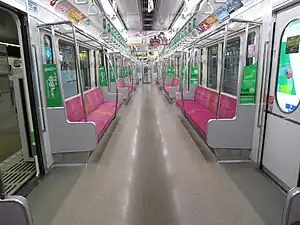Sendai Subway 1000 series
The Sendai Subway 1000N series (仙台市交通局1000N系電車) is a rapid transit electric multiple unit (EMU) train type operated on the Sendai Subway Namboku Line in Sendai, Japan.
| Sendai Subway 1000N series | |
|---|---|
 A Sendai Subway 1000N series train, October 2008 | |
 Interior | |
| In service | 1987–present |
| Manufacturer | Kawasaki |
| Constructed | 1985–2007 |
| Refurbished | 2004–2013 |
| Number built | 84 vehicles (21 sets) |
| Formation | 4 cars per trainset |
| Capacity | 144 passengers per car (58 seating, 54 post-refurbishment) |
| Operator(s) | Sendai City Transportation Bureau |
| Line(s) served | Sendai Subway Namboku Line |
| Specifications | |
| Car length |
|
| Width | 2.89 m (9 ft 6 in) |
| Height | 4.04 m (13 ft 3 in) |
| Doors | 4 pairs per side |
| Maximum speed | 75 km/h (46.6 mph) |
| Weight | 128 t (126.0 long tons; 141.1 short tons) |
| Traction system | |
| Traction motors |
|
| Transmission | Westinghouse-Natal drive; gear ratio: 5.73 : 1 (86 / 15) |
| Acceleration |
|
| Deceleration |
|
| Electric system(s) | 1,500 V DC (nominal) from overhead catenary |
| Current collector(s) | Pantograph |
| Bogies | SS-005, SS-105 |
| Braking system(s) | Electromagnetic braking |
| Safety system(s) | ATC/ATO (Fuzzy logic) |
| Track gauge | 1,067 mm (3 ft 6 in) |
The 1000 series was the world's first train type to use fuzzy logic to control its speed, and this system developed by Hitachi[1] accounts for the relative smoothness of the starts and stops when compared to other trains, and is 10% more energy efficient than human-controlled acceleration.[2] It was the recipient of the 28th Laurel Prize award presented by the Japan Railfan Club.
Formation
Sets are formed as follows, with car 1 at the Tomizawa end.[3]
| Car No. | 1 | 2 | 3 | 4 |
|---|---|---|---|---|
| Designation | Tc1 | M1 | M2 | Tc2 |
| Numbering | 1100 | 1200 | 1300 | 1600 |
Refurbishment
From 2004 until 2013, the 1000 series trains underwent mid-life refurbishment to extend their lifespan. As of April 2009, 12 sets have been refurbished,[4] and the refurbished sets are renamed 1000N series.
The refurbished trains include the following features.
- LED destination indicators at the train ends
- Space for wheelchairs
- Air-conditioning
- LED destination indicators inside trains
See also
References
- Andrew Pollack (2 April 1989). "Fuzzy Computer Theory: How to Mimic the Mind?". The New York Times. Retrieved 11 March 2011.
- Philip Elmer-DeWitt (25 September 1989). "Time For Some Fuzzy Thinking". Time. Archived from the original on 22 October 2010. Retrieved 11 March 2011.
- 私鉄車両編成表2021 [Private Railway Vehicle Organization Table 2021] (in Japanese). Japan: Kotsu Shimbunsha. 2021. p. 12. ISBN 9784330032214.
- 資 料 2【車両デザインガイドラインについて】 (PDF). www.city.sendai.jp (in Japanese). Archived from the original (PDF) on 18 July 2011. Retrieved 11 March 2011.